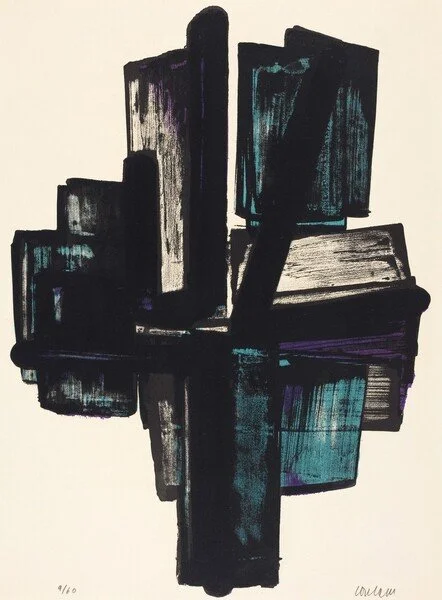Pierre Soulages
Pierre Soulages, one of France's most celebrated contemporary artists, is renowned for his groundbreaking work with the color black and his exploration of texture, light, and the materiality of paint. Known as the “painter of black,” Soulages created a body of work that redefined the way artists approach color and abstraction. His paintings, often monumental in scale, engage in a dynamic dialogue between light and shadow, form and formlessness. Through his innovative techniques, Soulages sought to bring new meaning to the act of painting itself, elevating the surface of the canvas to an active participant in the creation of meaning.
Soulages’s best-known works are his *Noirs* (Black paintings), where he used black paint not as a void but as a medium full of texture, depth, and reflective qualities. In these works, such as *Peinture 130 x 162 cm, 1959* (1959), the surface of the canvas becomes a landscape in itself, with deeply incised lines, scraped textures, and layers of paint that interact with the light in varying ways. Soulages’s use of black is never static or uniform; instead, it is a vibrant, living element, shaped by the artist's gestures and the interplay of light across the canvas. The black becomes a mirror, a surface that not only absorbs light but also reflects it, creating a sense of movement and depth within the simplicity of the monochrome.
Pierre Soulages, Peinture 195 x 130 cm, 4 août 1961
Soulages’s approach to abstraction was revolutionary in its use of non-traditional techniques. Rather than applying color in a conventional manner, Soulages often used brushes, knives, and even his hands to create textured surfaces that ranged from smooth, polished expanses to deeply carved, dramatic forms. His manipulation of paint—whether by scraping, scoring, or layering—emphasized the physicality of the medium itself, making the process of painting an integral part of the final work. For Soulages, the surface was as important as the imagery it conveyed, transforming the canvas into an object of tactile and visual exploration.
Born in Rodez, France, Soulages studied at the École des beaux-arts in Toulouse before embarking on a career that would establish him as a central figure in European abstraction. Though his early works were influenced by traditional figurative and abstract painting, it was his discovery of black as a central theme in the 1940s that marked the beginning of his truly distinctive style. Soulages’s work transcended the boundaries of both abstraction and traditional painting, as he sought to express not just visual beauty, but the metaphysical properties of light, time, and space. Over the decades, Soulages developed a language of abstraction that was both deeply personal and universally resonant.
Soulages’s art has had a profound impact on the development of abstract art, particularly in his focus on the relationship between light and material. His work, which ranges from his early “black paintings” to later works where color was introduced alongside black, continues to inspire artists and collectors worldwide. Soulages’s legacy is one of daring innovation and a lifelong commitment to exploring the spiritual and material properties of paint. His works, held in major collections such as the Centre Pompidou in Paris and the Museum of Modern Art in New York, remain a testament to the transformative power of color, texture, and light in the world of contemporary painting.
Pierre Soulages, Peinture 130 x 97 cm, 18 septembre 1980
Pierre Soulages, Peinture à l’huile sur toile, 1963
Pierre Soulages, Peinture 130 x 89 cm, 6 mars, 1955
Pierre Soulages, Composition III, 1957




